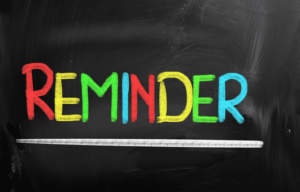Student Contributor: J. Ziemba
 Reminders are useful because they keep us organized and on task in our daily lives and offer valuable support to students. These reminders in the classroom prompt children to do the remembering themselves. Pulling up their memory of established expectations and allow students to decide on an action based on the expectation.
Reminders are useful because they keep us organized and on task in our daily lives and offer valuable support to students. These reminders in the classroom prompt children to do the remembering themselves. Pulling up their memory of established expectations and allow students to decide on an action based on the expectation.
Reminding language supports children in pausing and visualizing what to do before they take action on the expectation. Helps children develop the feeling of autonomy and competence that lead to self-control and intrinsic motivation. Over time, children begin to develop habits of attending carefully to expectations because they know they will have to remember them. Reminders are useful in a wide range of classroom situation such as group work and transitions. To make these reminders more effective you have to start by establishing expectation of your students clearly. Phrase a reminder as a question or a statement to allow students to think about the reminder. Use direct tone and neutral body language when giving the reminder to your class. You can only use reminders on what they already know. As a teacher, you have to hold a discussion about the expectations, then follow with interactive modeling and practice. You might use the Reminders tool, when practicing and discussing the class rules and procedures. This will allow students to understand the expectation and what needed to be remembered for the classroom environment. You can also use a pre-correction that involves reminding a child of appropriate behavior before the child can make an error.
Reminders are placed under the Supportive Phase, and it fits perfectly. With that being said, the Supportive phase is when the learning starts to begin. This phase is designed to be implemented once you suspect that students are wondering off task, it helps to redirect your strategies while still aiming to support student learning. Using reminding language before students start a challenging task, or when they start to make a mistake, reminders help get students back on task and be responsible. Before using reminders in the classroom, you have to make the expectations clear and show your students exactly how to meet them. Keeping yourself and your student calm makes the reminders more effective in the end. Giving the reminders early is important so that you get to the student before their behavior has gone on too long. Some keys to effective reminding language is to prompt the children to remember for themselves what they should be doing. Use neutral tone and body language. Be brief, if you take too long students tend to tune out. Watch for the follow-through, after giving a reminder make sure you take a moment to see if the child acts.
More Information –
Tool Source: The Power of Our Words: Teach Language That Helps Children Learn by Paula Denton


